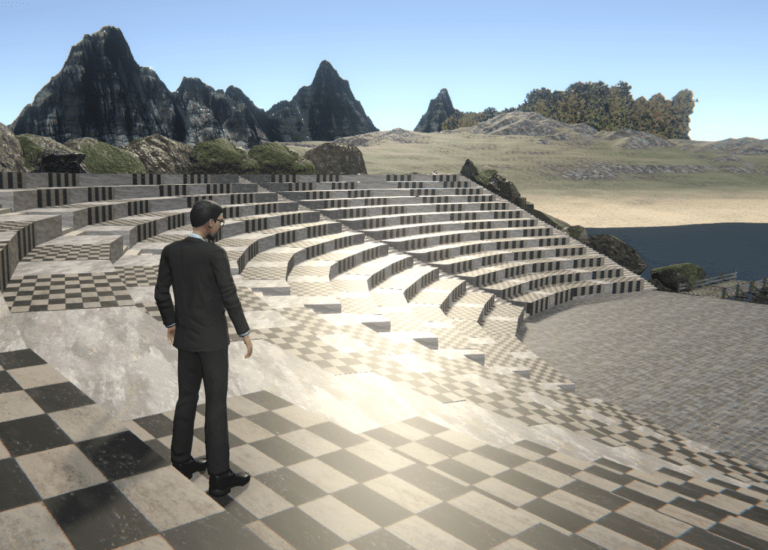
Dalton Salvo
Ph.D. candidate in English who’s researching the effectiveness of virtual environments
Dalton Salvo sees simulated classrooms as the future
As the world inches toward “normalcy,” it’s becoming apparent that some things will never be the same again. But perhaps that’s a good thing – maybe they were overdue for change in the first place. Dalton Salvo, a UCI Ph.D. candidate in English who’s researching the effectiveness of virtual environments, argues that the potential of remote learning, for example, has been largely untapped – until now, that is. Program, which trains advanced degree candidates to become future government leaders. As a public health analyst in CDER, Menglu is at the forefront of health policy, helping to shape FDA’s response to the current opioid crisis.

He believes that virtual worlds are “the next evolutionary step” not only for online education, but for classrooms in general. Salvo is putting that to the test at a one-day symposium that will be held later this quarter in Sinespace, an up-and-coming virtual world – specifically, in its offshoot platform, Breakroom. “Free Speech Today: Tensions & Intersections,” sponsored by the UC National Center for Free Speech and Civic Engagement and the UCI Humanities Center, will bring together students, scholars, legal practitioners and gaming industry experts to discuss the contemporary relevance of the First Amendment.
Salvo also hopes, for his dissertation, to apply his theoretical research in the creation of a writing course designed for and held entirely in Breakroom.
For the past five years, he had been studying how digital technologies such as virtual reality immerse their users and keep them engaged through creativity and exploration. Then the pandemic hit, and students and employees around the world had no choice but to work purely online. Suddenly, virtual worlds took on a new meaning: They could have real-world applications.
As both a student and a teacher, Salvo understands the multiple shortcomings of online learning: the Zoom fatigue, limitations of videoconferencing, boredom, lack of interaction, logistical difficulties of group work, etc. “My thinking has been to leverage a navigable virtual space as a way to maintain class engagement,” he says.
The key is to mimic the experience of an in-person class. “I’ve been arguing that that kind of setting and interactive capability is more likely to enhance participation because it more closely simulates reality,” Salvo says. “Just in terms of sheer logistics – at least as a Zoom or videoconferencing alternative – Breakroom offers all the same functionalities but so much more on top of that.”
Although the platform is similar to Second Life – users can craft an avatar, build and explore environments, and communicate with others – Breakroom runs on a superior engine, he says, and also offers the ability to videoconference and screen-share like Zoom, making it ideal for educational and professional purposes. In addition, it allows the creation of fully contained infrastructures, meaning that UCI could develop its own “UCI Breakroom” within the platform, accessible only to UCI staff and students.
A new social experience
“The one thing missing from online conferences these days is the ability to network, socialize and communicate on a small scale,” Salvo says. Along with speakers, the upcoming virtual conference will have booths – and people manning them. Navigating through an avatar, users will be able to visit any station, talk, share information or have a conversation with a group in a courtyard – valuable activities at an event focused on free speech.
But the classroom holds special intrigue for Salvo, especially as the country transitions to an educational system that will be more hybridized than it was before. “In virtual spaces, you’re not limited to just a classroom,” he says. “You can create fully explorable and interactive environments.”
In Breakroom, group activity is easier to manage than in traditional online education spaces. An instructor can begin the class with a lecture, then avatars can teleport to assigned breakout rooms for collaborative work. Each room has its own audio channel, so only the people inside can hear and communicate with each other. The teacher can pop in and out of all these different spaces to oversee and help by simply clicking on various tabs.
The classroom itself could be constructed with a specific theme at its core, depending on the subject being taught. It can be a prefabricated dynamic environment that any student can plug into to “play” or upload documents. The spaces are persistent, so students can explore and interact with them at their own leisure – and even build in them if the instructor allows it.
“I teach the video game theme, so I could create, in a sense, an interactive museum exhibit to showcase a specific topic,” Salvo explains. “For instance, I can have a ‘violence in video games’ station, where I have video clips of violent video games and their history. And you can even create a timeline for navigation.”
Limitless possibilities
Some of Breakroom’s greatest advantages are simply due to the lack of physical constraints. Schools can only build so many lecture halls and classrooms, Salvo notes, and those can only house so many students at a time. Mandatory classes, which are always in high demand, could be held on virtual platforms.
“If we implemented this robust virtual infrastructure, we’d no longer be limited by any kind of concern for physical space,” Salvo says. “We’d only be limited by our available instructors. We could supplement our physical infrastructure with a virtual one as a way to meet demand more efficiently. This is a cost-effective way of expanding reach.”
Introverted students and those with long commutes could also benefit from virtual classes, he adds.
“I’m not saying we replace in-person teaching with this, but moving to this kind of social-virtual world would be better than traditional online school,” Salvo says. “Online school hasn’t fundamentally changed since it was invented.”
The lessons he has taken from his research journey are part of the pandemic’s silver lining: the opportunity to grow in fundamental aspects of society.
“COVID has been terrible, but it has clearly demonstrated the need for innovation in our current remote learning educational systems,” Salvo says. “Virtual platforms would be a dramatic improvement. They would allow us to progress and develop new ways of teaching and new ways of interacting with our community.”